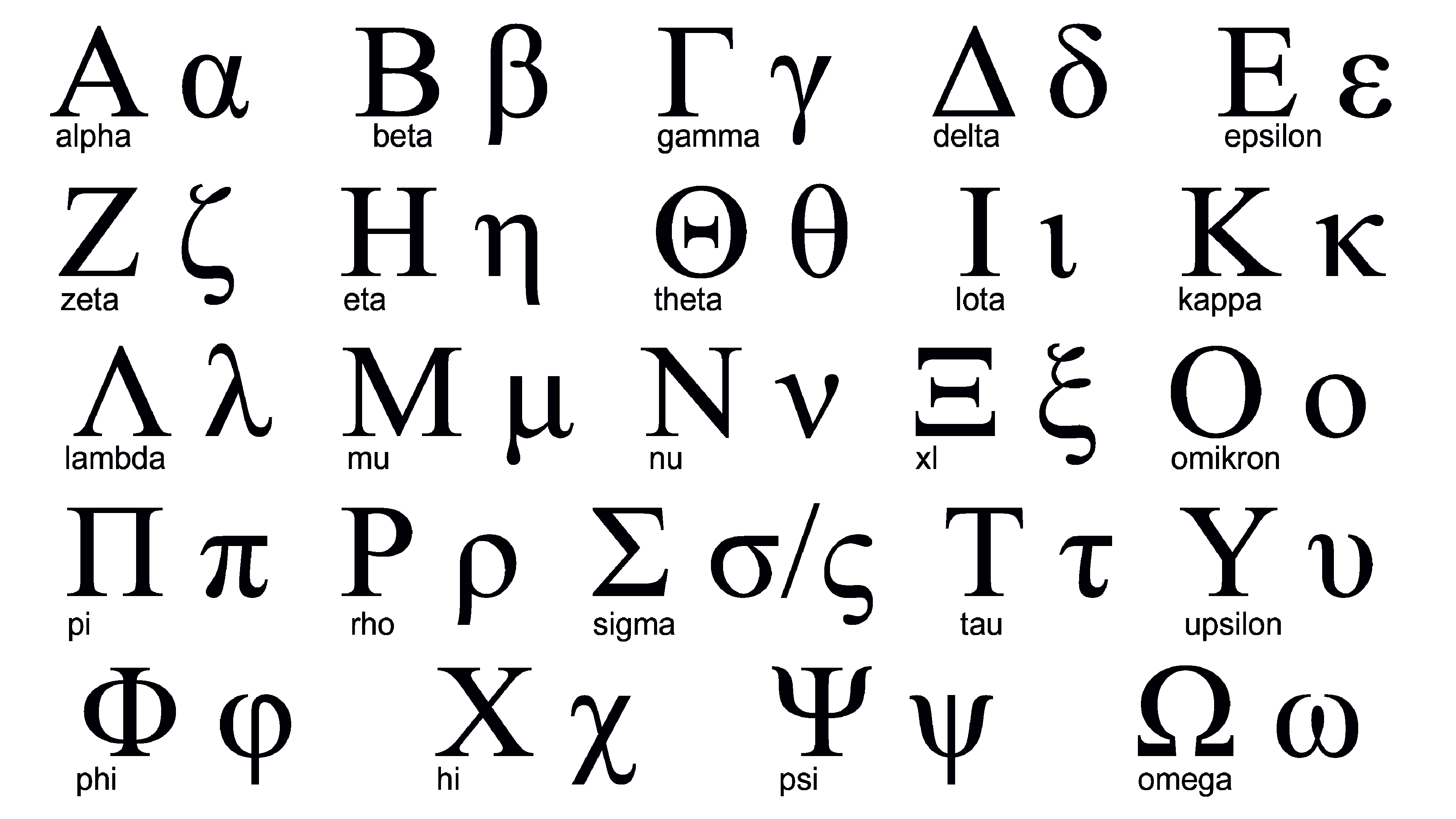Greek alphabet (full version) with Greek letters
The Greek alphabet, or if we use it for writing, Ελληνικό αλφάβητο, is used in the Greek language and a rather small Greek language group. Despite this, it is one of the oldest and most studied alphabets ever, which was presumably introduced first in the ninth century. The word “Alphabet”, which we all use now for any language, was also borrowed from the Greeks, and consists of the names of the first two letters: “Alpha” and “Beta”. Both modern and ancient Greek alphabets consist of 24 letters: 7 vowels and 17 consonants.
Today the letters of the Greek alphabet can be seen not only in Greek texts. Many symbols are widely used in geometry, physics, astronomy, and other sciences. In manuscripts and printed editions, one can find Greek ligatures — the fusion of two or more letters into one symbol to reduce space and speed up writing.
In the long history of mankind, a great number of languages and alphabets have been created. At this point most of them are dead and some are lost altogether. One branch of alphabet development has been fundamental to most languages. It is the offshoot of the Phoenician branch that gave rise to the Greek alphabet. Because of the number of books and the trade the Greek alphabet became popular. Greek can be called the first world language and as a consequence, the Greek alphabet can be considered the first world alphabet. Over time, the Greek alphabet has undergone many changes and the Latin alphabet emerged on its basis.
 The History of the Greek Alphabet
The History of the Greek Alphabet
Almost all European alphabets have their origins in the Greek alphabet. In the West, the alphabet spread through the Greek colonies in the southern part of the Apennine Peninsula.
From the Greeks, the alphabet was borrowed by the Romans, and from them, it spread to all the countries of Western Europe. At the end of the 4th — beginning of the 5th centuries, the alphabet influenced the emergence of the Armenian alphabet. In the 6th century, the Georgian alphabet emerged from part of the Greek alphabet with the addition of several letters.
But what about the creation of the Greek Alphabet itself? How did it appear and what was it based on?
The letters of the Greek alphabet were borrowed in part from Phoenician consonantal typewriting, which means only consonantal sounds were used. Because of the peculiarity of the Greek language, some symbols denoting consonants began to be used to record vowel sounds. Thus, the Greek alphabet can be considered the first in the history of writing, which consisted of vowels and consonants.
Phoenician letters changed not only their style but also their names. Initially, all symbols of the Phoenician system of writing had names that denoted a word and indicated the initial letter of that word. In the Greek transcription, the words slightly changed their sound, and the semantic load was lost. New symbols were also added to indicate missing vowel sounds.
The Symbolism in the Greek Alphabet
The Greek alphabet is represented by 24 characters. Each of them has a complete system of meanings, both symbolic and numeric. Unlike the Latin alphabet, like the Phoenician and Hebrew alphabets, Greek letters also denote numbers. This provides significant opportunities to use the alphabet for magical purposes.
The Greek alphabet served as the basis for the numerical system developed by the followers of Pythagoras as well as for the numerical magic of Christian mysticism. It should be added that the Greek alphabet is a magical system with several esoteric correspondences that give it powerful potential for divination and fortune-telling. Here it is a clear parallel to the runes, which are better known in this respect. Like the runes, each Greek letter has its special name, meaning, and numerical expression, all of which can be applied to divination.
The Letters of the Greek Alphabet
Many people find the Greek alphabet unusual: it is not similar to the Cyrillic and Latin alphabets, but it is not as distant as it may seem at first sight. Many letters of the Greek alphabet have been known since high school: in lessons of mathematics, physics, and chemistry each of us has diligently written out those little letters, hardly thinking that they can denote not only the density or amount of matter but also to write or speak properly.
Although, most of the Greek letters can be met outside of the Greek language, there still are some symbols, which are used only for writing in Greek. Below we will discuss each letter of the Greek alphabet individually.
Α α – the first letter of the alphabet, a derivative of the Phoenician “Aleph” (άλφα, alpha). The literal meaning of the letter is “a bull” or, more generally, “cattle”. The latter has also a numerical and esoteric meaning and has lots of parallels with Alef, the first letter of the Hebrew alphabet. The esoteric essence of Alpha assumes care of cattle, as well as the increase and wise use of the resources. Alpha is primarily interpreted as a symbol of movable property in all its aspects. In numerical terms, Alpha symbolizes the paramount and most important – the primary concern for the maintenance of human life. The letter can often be seen in maths and science formulas, as it is used to indicate alpha rhythm in medicine and flat angles in mathematics.
Β ϐ – the second letter of the Greek Alphabet, the prototype of the Phoenician “bet” (beta, vita). Numerically it denotes the number 2; it is the next, not the first, and is therefore seen as a breaker of unity, and in dualistic religions, it is identified with a demonic challenge to the one God. Often this symbol is called “another first”, paying tribute to the atmosphere of the challenge created by this second, which is always trying to take the place of the first through rivalry or overthrow. All religions that recognize the existence of a creator of the universe are reconciled to this necessity, represented here symbolically by the letter Beta. In addition, some argue that the second quality is not necessarily diametrically opposed to the original principle.
Γ γ – the third letter of the alphabet, which stands for the number 3 and symbolizes piety and holiness. Originated from the Phoenician “gaml, gimel” (γάμα, gamma). In a general sense, the letter Gamma symbolizes the trinity of the deity, which is found everywhere. In Christian terminology, Gamma is a trinity – God the Father, Son, and Holy Spirit. In esoteric terms, Gamma is the triple process: creation, existence, and destruction; beginning, middle, and end; birth, life, and death. It is the third phase, the waning moon phase, which leads to the waning of light, that indicates the hidden meaning of new birth in a new cycle. Gamma radiation in physics and some variables in mathematics are denoted by this letter.
Δ δ – the fourth letter of the Greek alphabet. The delta represents the four classical elements of the universe – fire, air, water, and earth and stands for the number 4. The Phoenician “delt, dalet” gave this letter its name (δέλτα, delta). This letter denotes variables in physics, and chemistry, as well as the brightness of a star in astronomy. Delta was the first element of human intervention, aimed at changing the world in a primitive state. The unusual number 4 is the four directions, four horses in a wagon known as the quadriga, and the four horsemen of the Apocalypse. It is a symbol of completeness on the material level and the quality of completeness.
Ε ε – the fifth letter of the alphabet, Epsilon, is a derivative of the Phoenician letter “he” (έψιλον). The letter Epsilon (Ε ε) is often confused with Upsilon (ϒ υ), but they are completely different. The letter, standing for the number 5, represents the spiritual element contained in the material, and at the same time being outside of it. Traditionally, this element is depicted pentagram in the form of a five-pointed star. It contained the sacred proportions of the golden ratio, one of the three principles of sacred geometry, which were taken into account when designing the Parthenon and the Temple of Zeus. An Epsilon sign can be found in physics, chemistry, astronomy, mathematical analysis, and programming.
Ζ ζ – the sixth letter of the Greek alphabet, Zeta, comes from the Phoenician letter “zen, zain”. It denotes the giving of gifts or sacrifice to God. In esoteric terms, Zeta is the seventh letter of the alphabet, as the sixth letter was Digamma, which was removed before the classical period and now is only used as a number. As the seventh, and yet the sixth letter, Zeta represents the forming principle of the universe. (According to biblical tradition, the universe was created within six days, and the seventh day of rest was intended for completion.) Also geometrically number six is a directing principle of the matter, forming hexagonal lattices which underlie matter structure. Six points of a hexagonal lattice are necessary for placing inside the seventh point. Zeta stands for symbols in mathematics, as well as some meanings in hydraulics and surveying.
Η η – the seventh letter of the Greek alphabet, Eta, is a derivative of the Phoenician letter “het” (ήτα). symbolizing the energy of joy and love. It is the letter of equilibrium, a quality that implies harmony with the world around you and the ability to be in the right place at the right time and unleash your full potential. In Christian number science, Eta represents the pursuit of perfection, renewal, and salvation. But numerically, Eta represents the number 8, the prime number of the Sun. Today Eta is used to denote quantities in quantum physics, cosmetology, and thermodynamics.
Θ ϑ – the eighth letter of the alphabet, Theta, is derived from the Phoenician letter “tet”. This letter stands for the number 9, indicating the esoteric relationship between the numbers 8 and 9 (it even looks like the number 9 when written in the lowercase). The letter is a symbol of balance and unification, internal harmony, which has always meant a lot in all religions. Theta also symbolizes the octal division of time and space. Today this letter is used to refer to the values of variables in resistance to materials, electromechanics, and medicine (theta rhythm).
Ι ι – the ninth letter of the Greek alphabet, Iota, has originated from the Phoenician “iodine” (γιώτα). It was the smallest letter of all, giving birth to the biblical saying “cannot be changed one iota”. Despite its smallest size, Iota symbolizes destiny. It is dedicated to the goddess of destiny Ananke and thus also to the three parks. Iota is also a symbol of insignificance, if something is not worth even “iota”, but when someone tempts the fate, the thing that could seem unimportant in the beginning can turn against him and bring misfortune.
Κ κ – the tenth letter of the Greek alphabet, Kappa, originated from the Phoenician “kaf” (κάππα, κάπα), it gave rise to the Latin K and Cyrillic K. Kappa is considered a letter that brings failure, disease, and even death. Accordingly, it is dedicated to the god Cronus. In Mithraism, this tenth letter of the Greek alphabet is associated with evil. On a more abstract level, Kappa is the letter of the time, the bearer of inevitable and inexorable processes. In this respect, it is related to the rune Ken, which represents the inexorable process of the element of fire. Kappa stands for the number 20. Today the letter is used to represent symbols in physics, chemistry, and differential geometry.
Λ λ – the eleventh letter of the alphabet, Lambda, takes its origin from the Phoenician “lamda, lamed” (λάμδα, λάμβδα). Standing for the number 30, Lambda is connected with the growth of plants and geometrical progressions in mathematics which express a basic principle of any organic growth. Mystically it is connected with the geometrical proportion known under the name the Golden Section. As the eleventh letter of the Greek alphabet, Lambda represents ascension to a higher level. Mathematically it is proved on the example of two Lambda progressions: geometrical and arithmetic, basic number series of ancient Greek mathematics. At a more abstract level, Lambda means increasing numerical sequences underlying all physical processes. Today the letter is used to denote symbols in linguistics, linear algebra, and virology to denote bacteriophages.
Μ μ – the twelfth letter of the Greek alphabet, Mu, originated from the Phoenician letter “meme” and gave the name to the Latin M and Cyrillic M (μῦ). It represents the sacred number 40. This letter is associated with trees, the largest, most powerful, and enduring representatives of the plant kingdom. The tree is the symbol of the cosmic axis. It is the link that connects the underground, earthly, and heavens. Its roots grow underground in the kingdom of Hades. It penetrates the surface of the earthly world, where mankind lives, and then rises to the heavenly empires of the gods and goddesses. Cosmically, as the twelfth letter, it implies all twelve months of the year, the completed cycle of all life on Earth. Today Mu is used to denote quantities in mathematics, physics, and thermodynamics.
Ν ν – the thirteens letter of the alphabet is Nu. The prototype of this letter in the Phoenician alphabet is “nun” (nu, ni). The number 13 has a darker semantic meaning — it is linked to the Great Goddess Hecate. The Greeks worshipped Hecate as the goddess of night and the underworld. Here we also see a connection between the Egyptian goddess Nut and the later Scandinavian goddess of the night Noth. As well as her runic twin Nid, the letter Nu symbolizes the unpleasant necessity; of night darkness as the need to make the daylight up again. The letter stands for the number 50. It denotes the amount of matter in physics and chemistry, as well as neutrinos and the frequency of waves.
Ξ ξ – the fourteens letter of the Greek alphabet, Xi, originated from the Phoenician “seek or Samekh” (ξι, xi). According to the esoteric interpretation of the alphabet, this letter represents the stars, more precisely, 15 stars. These stars and constellations are significant because they are traditionally attributed to certain qualities and influences. Standard astrology considers that these stars have specific properties. As a consequence, they are treated the same way as the most famous planets. This letter refers to the number 60, a favorite number of ancient Babylonian astronomy.
Ο ο – the fifteenth letter of the Greek alphabet is Omicron, the prototype of the Phoenician letter “ain” (όμικρον, omicron). Omicron is the encircled power of the sun, the source of all energy on Earth, whose various aspects are symbolically represented by the gods’ Helios and Apollo. The circular shape of the letter recalls the appearance of the sun and the eternal essence of light amidst the cosmic darkness. In a later interpretation, Omicron symbolizes Christ as the bearer of light. On the other hand, Omicron represents the moon, the mirror of the sun. The Gnostics refer to the fifth heaven with this letter. It has a numerical value of 70.
Π π – the sixteenth letter of the Greek alphabet, Pi, takes its roots from the Phoenician letter “pe” (πι, pi). The letter Pi symbolizes the sun in the splendor of glory, but not its disk, but a round shape surrounded by sixteen rays, which are identified with all the solar deities. More specifically, it is associated with Mitra, to whose veneration the sixteenth day of each month was dedicated. The sun, surrounded by sixteen rays, much later becomes the property of Christian art, where it is also associated with the name of God. Pi stands for the number 80 and is used to denote a mathematical constant, potential energy, and transition probability matrix.
Ρ ρ – the seventeenth letter of the alphabet, Rho, originates from the Phoenician letter “Rosh / resh” (ρω). It represents the creative feminine qualities that are in everything and inherent in both sexes, male and female. More specifically, it is understood as fertility, the developmental power of all plant life, and the ability of a living organism to reproduce. Today the letter can be found as a designation in mathematics, physics, and chemistry. Arithmetically this letter denotes the number 100.
Σ σ/ς – the eighteens letter of the Greek alphabet, Sigma, originated from the Phoenician letter “sin, shin” (σίγμα). Sigma is the Lord of Death; in the Greek pantheon, she is a symbol of Hermes Psychopomp, the guide of souls to the afterlife. As the eighteenth in number, it is associated with the mysterious eighteenth rune of the Scandinavian tradition, as well as the esoteric properties of the eighteenth letter of the Gaelic alphabet. Sigma stands for the number 200. Today it is used to denote variables in algebra, chemistry, electronics, quantum mechanics, and also in medicine (it gave the name to the sigmoid colon).
Τ τ – the nineteenth letter of the Greek alphabet, Tau, takes its origin from the Phoenician “tav” (ταυ). Tau represents a microcosm, or in a narrower sense, the lunar aspect of man. The cross of the letter Tau often served as the main pictographic form of depicting the human body. It appears to be derived from the ancient Egyptian inscription of the sign Ankh, a symbol of eternal life used in magic as an amulet against infertility. In Christian iconography, Tau is a cross (letter T in Latin and Cyrillic alphabets). In esoteric Christian symbolism, the three ends of the letter Tau represent the trinity. The arithmetic value of Tau is 300; according to the rules of gematria, this letter represents the Moon goddess Selene This letter is often found in astronomy, it denotes the stars in the constellations. It can also be found in chemistry, mathematics, and mechanics.
ϒ υ – the twentieth letter of the alphabet, Upsilon (the one that is often confused with Epsilon) originated from the Phoenician letter “vav” (ύψιλον). The letter denotes water and the properties of fluidity. Upsilon represents the properties that are like flowing streams of water and difficult to define, but at the same time essential for the continuation of life. The number 20 in Greek mysticism is also associated with water. The letter stands for the number 400, not 20. Gnostic tradition associates the letter Upsilon with “the sixth heaven”.
Φ φ – the twenty-first letter of the alphabet is Phi, which does not have Phoenician roots, and the origin of this letter is unknown. Phi is the phallus, the male principle of reproduction. Phi stands for the number 500. In gematria, this number is identified with the mystical shell, a manifestation of the spiritual element in the world of forms. The letter φ denotes the golden ratio in architecture, art, and mathematics. It is also used to denote variables in physics, chemistry, and electrical engineering.
Χ χ – the twenty-second letter, Hee, is only found in the new Greek, as in the ancient Greek alphabet there was no such letter. Hee stands for the cosmos, and on the human level, private property. It is also a symbol of the gift presented, which in the horizontal plane connects man with man, and if you look vertically, it is a link of unity of the gods with mankind. The letter represents the number 600. This sign denotes symbols in chemistry, physics, and topology.
Ψ ψ – the twenty-third letter of the Greek alphabet, Psi, can’t be found in the ancient version either. This letter gave rise to such words as “psychology”, and “psychiatry”. Psi denotes the heavenly light embodied in the sky god Zeus. It also has a secondary meaning, daylight, and more specifically — the culmination of noon. Hence, this letter corresponds to the moment of illumination, and clear and precise vision. Psi stands for the number 700.
Ω ω – the twenty-fourth and last letter of the Greek alphabet is Omega. It comes from the Phoenician “ein” (ὦμέγα). This is the last letter of the Greek alphabet, it is associated with the ending of something. Alpha and Omega in the Bible mean the beginning and the end. Omega also signifies wealth and abundance, the successful completion of things. Its numerical value is 800, equivalent to “Pistis”, which is “faith”, and “kyrios”, meaning “lord”. Thus, Omega is the embodiment of faith and the divine plan. Today the sign is used in ballistics to denote the mass of a charge, as well as in physics and geometry — symbols.
Additional Greek Symbols (defunct and archaic)
- Ϝ, ϝ — digamma, used to be the sixth letter of the archaic Greek alphabet. The name “digamma” (δίγαμμα), is associated with the shape of the letter, “double gamma”. Originally, the letter was derived from the Phoenician “vav” (ϝαῦ), just like the Upsilon. In ancient times it was used in the system of Greek alphabetic recording of numbers with the value of 6, but later it was replaced by Stigma.
- Ϻ, ϻ — san, another defunct letter of the Greek alphabet. It is derived from the Phoenician letter tsadi. San was an archaic letter of the Greek alphabet. Its form was similar to the modern Mu, and it was used as an alternative to sigma to denote the sound S . In addition to denoting this separate archaic symbol, the name “San” was also used as an alternative name for the standard letter Sigma. Another archaic Greek letter, Sampi was formed out of San.
- Ϙ, ϙ — coppa, the archaic letter which was used for the posterior allophone from/to/before the posterior vowels [o, i], was originally common to most epichoric alphabets.
- Ϛ, ϛ — stigma, a ligature of the Greek letters Sigma and tau, is sometimes used in modern times to denote the Greek numeral 6. The letter was used in writing Greek between the Middle Ages and the 19th century. In this unrelated function, it is an extension of the old letter digamma, which has served as a numerator since ancient times.
- Ϡ, ϡ — sampi, a special letter, which was used by some Ionian cities to represent the whistling sound. This symbol later fell out of alphabetic use but survived as the numerical symbol sampi.
- Ⱶ, ⱶ — heta, the letter that had two different functions, both derived from the name of its Phoenician model, heta. Heta was used instead to denote the long vowel. In some regions, it was used for both / h / and / ɛː / without distinction.








































